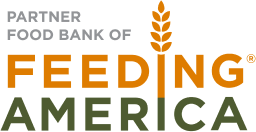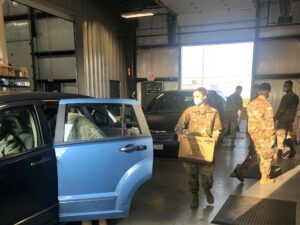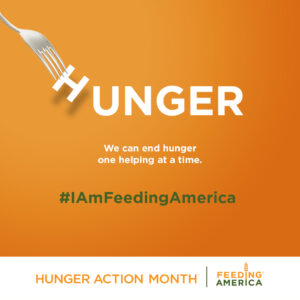SNAP is critical to our hunger relief work – here’s why
9.5 million American families depend on SNAP to make ends meet
By: Emily Gallion, Grants & Metrics Manager/Advocacy Manager, and Caitlyn McIntosh, Outreach/SNAP Lead
In times of crisis, the Supplemental Nutrition Assistance Program (SNAP, formerly known as the Food Stamp Program) is our nation’s first line of defense against hunger. This program is critical now more than ever.
According to a report funded by the Food Research and Action Center (FRAC), the number of American adults who are food insecure has reached 29 million — nearly three times as many as two years ago. Food insecurity rates are twice as high among Black and Latino households.
In The Foodbank’s own service area of Montgomery, Greene, and Preble counties, Feeding America estimated the number of food insecure individuals would reach 144,210 people in the wake of the pandemic.
We are doing everything in our power to acquire and distribute enough food to serve families in need of assistance during this difficult time. For decades, SNAP has provided critical support to the work we do.
A Snapshot of the Program
The Supplemental Nutrition Assistance Program (SNAP), previously known as the Food Stamps Program (FSP), originated from a 1939 United States Department of Agriculture (USDA) program in which participants purchased physical stamps.
For every $1 of orange stamps, which could be redeemed for any food item that an individual purchased, they would receive 50 cents’ worth of blue stamps, which could only be used on foods designated surplus by the USDA.
The program underwent a series of revisions and became permanent in 1964 under the Food Stamp Act. Physical food stamps were transitioned to Electronic Benefits Transfer (EBT) cards during the 2000s. The program was renamed SNAP in 2008.
Currently, anyone living at or below 130% of the Federal Poverty Limit is eligible to receive SNAP benefits. A household of four people must make less than $2,790 a month to be eligible for the program. The same household can receive a maximum monthly allotment of $646, scaled based on income.
For more information about SNAP eligibility, visit the USDA’s SNAP FAQ page.
Nationwide, 9.5 million households depend on SNAP. As critical as food banks are to relieving hunger, for every meal provided by a Feeding America food bank, SNAP provides nine. We emphasize how important SNAP is because we know how difficult it would be to meet the needs of our community without it.
SNAP in Action During COVID-19
One of the reasons SNAP is so effective is it provides a pre-existing structure for emergency relief in times of economic difficulties. A clear example of this is the Pandemic-Electronic Benefit Transfer (P-EBT), which was deployed earlier this year.
This year has been incredibly challenging for everyone, but an even bigger burden was placed on families who were already struggling with food insecurity. P-EBT was created as a first line of defense for those families.
The P-EBT program was created as part of the Families First Coronavirus Response Act of 2020 to provide kindergarten through 12th grade children with temporary SNAP benefits. Children who qualify for free or reduced meals will receive $5.70 in SNAP benefits for each day school is closed due to COVID-19.
On September 5th, the Ohio Department of Jobs & Family Services received approval to expand this program for kids who are learning virtually for the 2020-2021 school year.
For more information on the P-EBT program, visit the ODJFS website.
In addition to helping families afford a nutritious diet, SNAP is also a huge factor in stimulating the economy. Every $1 of SNAP benefits injects $1.50 back into the economy. This system is very beneficial in recessions, or in 2020’s case — a pandemic, when people are underemployed or unemployed all together. SNAP gives people a safety net for those choosing between paying for food and everyday expenses.
Room to Grow
While SNAP is an incredibly effective tool to increase families’ food security, it typically does not cover the full cost of a low-cost diet. According to a 2018 study by Feeding America and the Urban Institute, in 99 percent of US counties, the maximum SNAP per meal benefit is lower than the average cost of a meal.
In Montgomery, Greene, and Preble counties of Ohio, the maximum SNAP per-meal benefit is $1.86, while the average meal costs $2.15. Click here to view the interactive map of the study’s findings.
As a consequence of this shortfall, SNAP households engage in a multitude of coping strategies to make ends meet. These include visiting food pantries, changing the size or frequency of meals, buying food on clearance, and other strategies, according to a 2018 study by Feeding America and American University.
However, nearly 60 percent of the households surveyed had one or more family members with a chronic illness or disability. The authors of the study noted that some of these strategies “may in fact undermine the quantity and the quality of food they consume, which may exacerbate their health conditions.”
SNAP is a life saving program. Feeding America is urging the nation’s political leaders to increase SNAP benefits by 15% due to the drastic impact the pandemic has had on families across America. Increasing SNAP will boost the economy and help keep American families out of poverty during this already difficult time.
Want to help out? You can use this tool to contact your representatives here.
As times remain uncertain, we are working harder than ever to ensure that no one goes hungry. To keep up with our SNAP and other hunger relief efforts, follow us on social media @thefoodbankinc.





No comment yet, add your voice below!